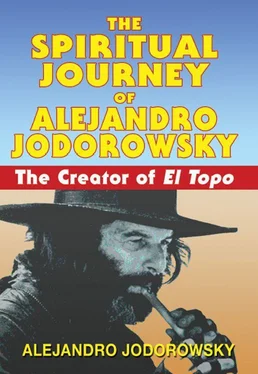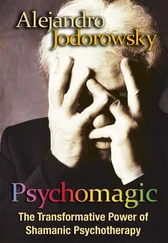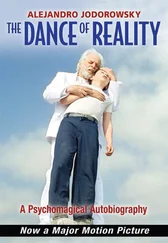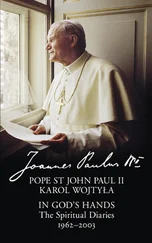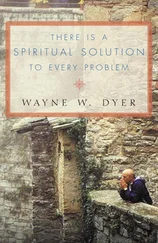The waitress, however, seems not to have heard: “How would you like your hamburger? With ketchup or mustard?” she asks the boy.
“With ketchup.”
“I’ll bring your order right away!” the waitress answers, leaving before the mother can say anything else.
There is a stunned silence around the table. Finally, the little boy looks at everyone and says: “Wow! The waitress thinks I’m a real person.”
This joke gave me the solution to the koan: I was there to satisfy my son’s desires, not my own. I called the waiter and ordered all twelve soups at once. When Teo saw the table covered with these bowls filled with exotic soups, he was in ecstasy. He ate only a few spoonfuls of each, but he was happy.
While I was working on The Holy Mountain , I had just finished shooting at the revered Our Lady of Guadalupe Church. Some groups of fanatic Catholics had spread the rumor that I had performed a black Mass inside the sacred place, and suddenly I was greeted by a parade of a thousand believers whipped into a frenzy by right-wing extremists. They shouted insults, comparing me to the murderer Charles Manson and demanding I be expelled from the country. This whole business was so baseless and absurd that I didn’t worry about it, thinking that the rumor would soon die down of its own accord. But it only grew worse. Newspapers seized on the situation to create a scandal, writing articles in which I appeared as the Antichrist.
One morning, there was a loud knock at my door. Three huge detectives, looking like professional killers, said roughly: “Come with us!” Without even allowing me to get my coat, they dragged me in my shirtsleeves into a black car and shoved me into the backseat, crushed between two of them.
They refused to say where we were going. After an anxious half hour of biting my lips, the car stopped in front of the Ministry of the Interior. Just as I feared, I was about to be deported from Mexico. I was led through numberless offices and waiting rooms full of solicitors, secretaries, bureaucrats, and policemen until I arrived finally before an imposing door. It opened.
Smiling broadly, Mario Moy Palencia received me. He offered me an armchair and then began (with no excuse or explanation for the violent nature of my summons).
“Jodorowsky — our president, the most honorable Luis Etcheverría, knows your work well and is one of your admirers. For example, this very year in his presidential report, he quoted one of your Panic Movement fables — the one in which the archer who has decided to hunt the moon shoots hundreds of arrows at it and is ridiculed by everyone. He never hits the moon, but he does become the best archer in the world.
“Do you see my point? The government is your friend — a very useful friend — but it can also become a dangerous enemy.”
As he said this, I felt a tremor, remembering the brutal assassination — with the complicity of the Mexican government — of a crowd of young students by paramilitary Falcon troops on June 10, 1971. The government claimed that only twenty-five were killed, but the people counted two thousand of their dead.
“Now listen carefully. A large number of complaints have been lodged against you. You cannot get away with attacking our institutions or our religion or army. If you don’t want something unpleasant to happen to you or to your family, then you must remove every religious image and every military or other official uniform from your film. I don’t want to see even a fireman’s uniform in that film! Now you may leave.”
I had to walk all the way home, because I had left without a penny in my pocket. That night, we were treated to raucous shouts at our windows: “We’re going to kill you!”
It was a very serious koan. If I obeyed and mutilated my film, I would kill it. If I disobeyed, I was risking my family’s lives as well as my own. I spent a sleepless night.
Very early the next morning, I took all the negatives, representing thirty-six hours of filming, and sent them secretly to the United States in an express truck via Tijuana. In two days, I withdrew all funds from my bank accounts, settled my rental contracts and telephone bills, sent a ton of boxes of books out of the country, and generally pulled up stakes. On the third day, I flew to New York with my wife, children, and our cat, Mandrake. This was before Roberto Viskin had decided to abscond to Israel, and he proved to be a good friend. I was able to finish the montage and editing of my film without censoring any scenes.
As I was preparing the casting for my film Dune (based on the science-fiction novel by Frank Herbert — a project that was never to see the light of day), Salvador Dali put me through a moment of trial. I wanted the famous painter to play the role of the mad galactic emperor, and the idea appealed to him. In order to take the measure of this young upstart talent who presumed to be capable of directing the great Dali, he invited me to dine in a luxurious restaurant in Paris. I found myself seated directly across the table from him, surrounded by a dozen of his hangers-on.
With no preamble, he asked me: “When Picasso and I were young, we would go to the beach together. Every time, we would find a watch there simply by pushing the sand around with our feet. Have you ever found a watch at the beach?”
The artist’s groupies watched me with contemptuous smirks. I had only a few seconds to reply. If I claimed to have found a watch at the beach, I’d pass for a liar. If I confessed I’d never found one, I’d be labeled as mediocre. But I didn’t even have to think about my answer; it came to me by itself:
“I’ve never found a watch in my life, but I’ve lost a great many!”
Dali coughed, paid no more attention to me, and began to occupy himself with his retinue — but at the end of the meal, he said to me: “Very well. I’ll sign the contract.” And then he added: “But I want to be the best-paid actor in the world: a hundred thousand dollars per hour.”
I changed the script so that the emperor possesses a wax-faced robot that looks like him, then I engaged Dali for only one hour. He appeared only in the scene where he was pushing the buttons on his robot in the laboratory.
For the role of the baron Harkonnen, a vulgar, cruel giant, I thought of Orson Welles. I knew he was in France but that he had become embittered at the lack of producers interested in his own work, and it was said that he wanted nothing more to do with film. Where could I find him? No one seemed to know. I had heard that the master had a passion for gourmet food and drink. I got an assistant to telephone all the best restaurants in Paris and find out if Orson Welles was a customer.
After countless calls, a small restaurant, Chez le Loup, told us that he came there once a week, though not on any specific day. I decided to dine there every night beginning on Monday. It was a discreetly elegant place with a fine menu and a superb wine selection. The owner himself took orders. Almost all the walls were decorated with Renoir reproductions. The one exception was a wall with a window. In front of it there was a broken chair. When I asked the owner about it, he said: “We are very proud of that piece of litter. One evening, Orson Welles sat in that chair and he ate so much that it broke.”
I returned every night. Finally, on Friday, the great man arrived, wrapped in an enormous black cape. I watched him with the same fascination as a child at the zoo. His appetite and his thirst were stupendous. I saw him devour nine different dishes and drink six bottles of wine. For dessert, I sent him a bottle of cognac that the owner had assured me was his favorite brand. When it came, he looked around and amiably invited me to his table. For a half hour, I listened to his monologue before daring to speak of the role. No sooner did I bring up the subject than he answered: “Acting doesn’t interest me. I detest contemporary cinema. It’s not an art; it’s a nauseating industry, a vast mirage born of prostitution.” My disappointment was immense, and I swallowed with difficulty. How could I inspire enthusiasm in him so that he would agree to work with me?
Читать дальше
